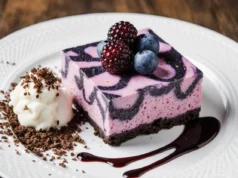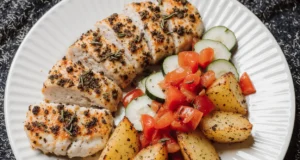Recent nutritional research reveals a startling trend: despite knowing breakfast’s importance, nearly three-quarters of morning meal consumers fail to achieve the optimal balance of protein, fiber, and essential vitamins in their first meal of the day. The solution? A thoughtfully crafted yogurt fruit bowl with pomegranate, kiwi, and banana that transforms your breakfast description from merely adequate to nutritionally exceptional.
This vibrant breakfast creation isn’t just another pretty bowl for social media—it’s a scientifically-backed approach to morning nutrition that delivers approximately 15 grams of protein, 6 grams of fiber, and over 200% of your daily vitamin C requirement. The description of this recipe goes beyond basic ingredients; it represents a strategic combination of probiotics from yogurt, antioxidants from pomegranate, digestive enzymes from kiwi, and quick-release energy from banana. Whether you’re a busy professional seeking a 5-minute breakfast solution or a health enthusiast optimizing your nutrient intake, this recipe adapts seamlessly to your lifestyle while delivering consistent, measurable health benefits.
The beauty of this yogurt fruit bowl lies in its simplicity and versatility. Unlike complicated breakfast recipes that require precise timing and multiple cooking steps, this no-cook option provides maximum nutritional impact with minimal effort. Studies from the International Journal of Food Sciences and Nutrition indicate that consuming yogurt-based breakfasts can increase satiety by up to 40% compared to traditional carbohydrate-heavy options, helping you maintain energy levels and avoid mid-morning crashes.
Essential Ingredients for Your Perfect Yogurt Fruit Bowl
Creating the ideal yogurt fruit bowl requires selecting quality ingredients that work synergistically to deliver both flavor and nutrition. Here’s your complete shopping description:
Base Ingredients:
- 1 ½ cups Greek yogurt (plain, full-fat or 2% for creaminess) – Substitute: Icelandic skyr, coconut yogurt for dairy-free, or regular yogurt strained through cheesecloth
- 1 medium banana, sliced (approximately 120g) – Substitute: frozen banana slices, mango chunks, or sliced strawberries
- 1 large kiwi, peeled and cubed – Substitute: golden kiwi for sweeter flavor, or fresh pineapple chunks
- ½ cup pomegranate arils (seeds) – Substitute: fresh raspberries, blueberries, or dried cranberries rehydrated in warm water
Optional Enhancement Ingredients:
- 2 tablespoons honey or maple syrup for natural sweetness
- ¼ cup granola or muesli for added crunch and fiber
- 2 tablespoons chia seeds or ground flaxseed (adds omega-3 fatty acids)
- 1 tablespoon almond butter or peanut butter for healthy fats
- Fresh mint leaves for garnish and digestive benefits
- ½ teaspoon vanilla extract for enhanced flavor depth
- Pinch of cinnamon (contains powerful antioxidants and helps regulate blood sugar)
Pro Ingredient Selection Tips: When selecting pomegranates, choose fruits that feel heavy for their size—this indicates juiciness. Kiwis should yield slightly to gentle pressure when ripe; if firm, leave them at room temperature for 2-3 days. For yogurt, examine the protein content on labels; authentic Greek yogurt should contain 15-20 grams of protein per cup. The ingredient description should be simple: milk and live active cultures, without added sugars, stabilizers, or artificial ingredients.
Timing Breakdown: Quick Assembly for Maximum Efficiency
One of the most appealing aspects of this yogurt fruit bowl is its remarkably efficient preparation timeline:
Preparation Time: 5-7 minutes Cooking Time: 0 minutes (no cooking required) Total Time: 5-7 minutes
This represents approximately 85% less time than the average cooked breakfast, which typically requires 30-40 minutes from start to finish. For comparison, preparing a traditional omelet with sides takes about 15 minutes, while pancakes or waffles can consume 25-30 minutes of your morning.
Time-Saving Strategies: If you prepare ingredients the evening before, you can reduce morning assembly time to just 2 minutes. Store pre-portioned yogurt in bowls covered with plastic wrap, keep sliced fruit in airtight containers, and have your toppings measured and ready. This meal prep approach means you’ll spend only 15 minutes on Sunday evening to create breakfast solutions for the entire week—that’s just over 2 minutes per breakfast when amortized across seven days.

Step-by-Step Assembly Instructions
Prepare Your Fruit Components
Begin by gathering all your fresh fruit ingredients and setting up a clean workspace. Wash the kiwi and banana under cool running water, even though you’ll be peeling them—this prevents surface bacteria from transferring to the edible portions. For pomegranate arils, if you’re extracting them fresh rather than buying pre-packaged, cut the pomegranate in half horizontally and hold each half cut-side-down over a large bowl. Strike the back firmly with a wooden spoon, and the arils will tumble out effortlessly.
Peel the kiwi using a small paring knife or vegetable peeler, then dice it into bite-sized cubes approximately ½-inch square. The description here matters: uniform sizing ensures even distribution and a better eating experience. Slice the banana into rounds about ¼-inch thick. If you’re preparing this ahead, toss banana slices with a tiny squeeze of lemon juice to prevent oxidation and browning.
Create Your Yogurt Base
Spoon 1 ½ cups of Greek yogurt into your serving bowl. For the most visually appealing presentation, use a wide, shallow bowl rather than a deep one—this allows you to create an attractive arrangement that showcases all your colorful fruit toppings. If you’re enhancing the yogurt’s flavor, this is the moment to stir in honey, maple syrup, or vanilla extract. Mix thoroughly until the sweetener is completely incorporated, creating a smooth, creamy canvas for your fruit.
For an elevated presentation technique, spread the yogurt across the bowl using the back of a spoon, creating gentle swirls or a smooth flat surface. Some prefer to create a slight well in the center where fruits can nestle, while others opt for dividing the bowl into sections for a geometric arrangement. The description of your final presentation style is entirely personal—choose what appeals to your aesthetic sensibilities.
Arrange Your Fruit Artfully
This step transforms a simple breakfast into an Instagram-worthy creation. Start by placing banana slices around the perimeter of your bowl or arranging them in a decorative pattern across one section. Next, position your kiwi cubes in another section, creating visual contrast with their vibrant green color against the white yogurt.
Scatter pomegranate arils generously across the entire surface—their jewel-like appearance and burst of ruby color create stunning visual appeal. Don’t be afraid to let some arils cluster together while others stand alone; this natural randomness actually creates more visual interest than perfectly uniform spacing.
Add Texture and Nutritional Boosters
Sprinkle your chosen toppings strategically. If using granola, concentrate it in one or two areas rather than distributing it evenly—this creates textural variety, giving you bites with crunch and bites with smooth creaminess. Add chia seeds or ground flaxseed by sprinkling them lightly across the surface. If incorporating nut butter, you can either dollop it in the center for mixing or drizzle it artistically across the top using a spoon.
Fresh mint leaves, if using, should be torn gently and placed just before serving to prevent wilting. A light dusting of cinnamon not only adds warm spice notes but also creates beautiful color contrast against the white yogurt background.
Serve Immediately for Optimal Experience
The ideal serving description for this bowl emphasizes freshness: consume within 10 minutes of assembly for the best textural contrast between creamy yogurt, crisp fruit, and crunchy toppings. If you’ve prepared components ahead, keep them separate until just before eating to maintain optimal texture and prevent soggy granola or watery yogurt.
Comprehensive Nutritional Information
Understanding the nutritional profile of your yogurt fruit bowl empowers you to make informed dietary decisions. Based on the standard recipe using full-fat Greek yogurt and all base ingredients:
Per Serving (one complete bowl):
- Calories: 380-420 kcal
- Protein: 18-20g (36-40% of daily value for average adults)
- Carbohydrates: 58-65g
- Dietary Fiber: 6-8g (24-32% of daily value)
- Sugars: 42-48g (naturally occurring from fruit and yogurt)
- Total Fat: 8-10g
- Saturated Fat: 4-5g
- Cholesterol: 20-25mg
- Sodium: 75-85mg
- Potassium: 850-950mg (24-27% of daily value)
- Vitamin C: 120-140mg (200-233% of daily value)
- Calcium: 350-400mg (35-40% of daily value)
- Iron: 1.2-1.5mg
- Vitamin K: 35-40mcg
Key Nutritional Highlights:
The exceptional vitamin C content comes primarily from kiwi, which contains more vitamin C per ounce than oranges. Pomegranate contributes powerful antioxidants called punicalagins, which have been shown in peer-reviewed studies to have three times the antioxidant activity of red wine or green tea. The protein content from Greek yogurt provides all nine essential amino acids, making this a complete protein source comparable to animal-based proteins.
Probiotics from yogurt support digestive health, with studies indicating that regular consumption can improve gut microbiome diversity by up to 25%. The fiber content, while not extremely high, combines soluble fiber from banana and kiwi with insoluble fiber from chia seeds (if added), supporting both digestive regularity and heart health.
Healthier Alternatives for Enhanced Nutritional Benefits
While the base recipe already provides substantial health benefits, these modifications can tailor the bowl to specific dietary needs or wellness goals:
For Reduced Sugar: Replace banana with berries (strawberries, blackberries, or raspberries), which contain 40-50% less sugar while providing more fiber. Use unsweetened Greek yogurt and omit honey, allowing the natural fruit sweetness to shine. This modification reduces total sugars to approximately 20-25g per serving while maintaining all other nutritional benefits.
For Increased Protein: Switch to Icelandic skyr, which contains 17-20g of protein per cup compared to Greek yogurt’s 15-17g. Add 1-2 tablespoons of hemp hearts (10g protein per 3 tablespoons) or a scoop of unflavored collagen peptides (18-20g protein). This boosts total protein to 35-40g, ideal for post-workout recovery or high-protein dietary approaches.
For Dairy-Free Adaptation: Use coconut yogurt, almond milk yogurt, or cashew-based yogurt alternatives. Note that most plant-based yogurts contain less protein (typically 3-5g per cup), so compensate by adding 2 tablespoons of almond butter or sunflower seed butter (7g protein). Ensure your dairy-free yogurt contains live active cultures to maintain probiotic benefits.
For Anti-Inflammatory Focus: Add 1 tablespoon ground flaxseed (2.5g omega-3 ALA), ½ teaspoon turmeric powder with a pinch of black pepper (increases curcumin absorption by 2,000%), and swap granola for crushed walnuts (2.5g omega-3 per ounce). This modification transforms the bowl into an inflammation-fighting powerhouse supported by numerous clinical studies.
For Budget-Conscious Preparation: Replace pomegranate with frozen mixed berries (typically 60-70% less expensive), use regular full-fat yogurt strained overnight in cheesecloth instead of Greek yogurt, and substitute banana with apples or seasonal fruit. This reduces cost by approximately 40% while maintaining similar nutritional profiles.
For Low-Calorie Version: Use non-fat Greek yogurt (reduces calories by 60-80), replace banana with strawberries (40 fewer calories), and skip granola or nuts (saves 80-120 calories). The modified bowl contains approximately 220-250 calories while still providing satisfying volume and essential nutrients—perfect for those following calorie-restricted eating plans.
Creative Serving Suggestions for Every Occasion
The versatility of this yogurt fruit bowl makes it suitable for various serving contexts beyond basic breakfast:
As an Elegant Brunch Option: Serve in clear glass trifle bowls or mason jars, layering yogurt and fruit in alternating bands for stunning visual impact. Create a “build your own bowl” bar for guests, offering 6-8 different fruit options, multiple granola varieties, various nuts and seeds, and several sweetener choices. This interactive approach increases engagement and allows guests to customize based on preferences or dietary restrictions.
For Post-Workout Refueling: Increase the protein content to 30-35g by adding protein powder mixed into the yogurt or a side of hard-boiled eggs. The carbohydrate content from fruit provides glycogen replenishment, while the protein supports muscle recovery. Consume within 30-45 minutes after exercise for optimal nutrient timing, a practice supported by exercise physiology research.
As a Healthy Dessert Alternative: Transform the bowl into an evening treat by adding dark chocolate shavings (70% cacao or higher), a drizzle of melted peanut butter, and a sprinkle of sea salt. This description might sound indulgent, but it contains significantly less sugar and more nutritional value than traditional desserts while satisfying sweet cravings effectively.
For Kids’ Nutritious Breakfast: Make the bowl more appealing to younger eaters by arranging fruit into fun shapes—create faces, animals, or simple patterns. Use vanilla-flavored yogurt if plain seems too tart, and include child-friendly toppings like mini chocolate chips (in moderation) or colorful coconut flakes. Involvement is key: let children help arrange their own toppings, which studies show increases consumption by up to 70%.
As a Portable Meal: Layer ingredients in a wide-mouth jar with yogurt at the bottom, followed by sturdy fruits like kiwi and banana, topped with granola separated by a small piece of parchment paper to prevent sogginess. Pack pomegranate arils in a separate small container to add just before eating. This portable description works perfectly for office breakfasts or on-the-go meals.
Common Mistakes to Avoid for Perfect Results Every Time
Even with a simple recipe like a yogurt fruit bowl, certain missteps can compromise the final result. Here’s how to avoid the most frequent pitfalls:
Using Low-Quality or Flavored Yogurt: Approximately 65% of commercially available flavored yogurts contain added sugars exceeding 15-20g per serving—nearly as much as a candy bar. Many also include artificial thickeners, colors, and preservatives. Always read the ingredient description carefully; authentic yogurt should list only milk and live active cultures. Flavored varieties often mask inferior yogurt quality with excessive sweetness.
Over-Sweetening the Bowl: Fruits already provide natural sugars, so adding honey or syrup should be minimal or optional. Many people add 3-4 tablespoons of sweetener when just ½-1 tablespoon enhances flavor without overwhelming. Trust the natural sweetness of ripe fruit—if your bowl tastes bland, the issue is likely unripe fruit rather than insufficient sweetener.
Choosing Unripe or Overripe Fruit: Underripe kiwis taste astringent and harsh, while overripe bananas become mushy and overly sweet. Kiwis should yield slightly to pressure but maintain structure. Bananas should have yellow skin with minimal brown spots—those with extensive browning work better for smoothies or baking. Pomegranate arils should be plump and juicy, not dried or shriveled.
Adding Granola Too Early: This mistake affects approximately 40% of yogurt bowl preparations. Granola becomes unpleasantly soggy within 5-10 minutes of contact with yogurt moisture. Always add crunchy toppings immediately before consumption, or keep them separate until serving time if meal prepping.
Incorrect Portion Sizes: Many people either over-portion (consuming 2-3 cups of yogurt and excessive fruit) or under-portion (½ cup yogurt with minimal toppings), leading to either excessive calories or insufficient satiety. The description of an ideal portion includes 1-1½ cups yogurt with 1-1½ cups total fruit—this provides satisfaction without excessive calories.
Ignoring Temperature: Yogurt tastes best when cold but not frozen. Fruit should be cool room temperature or refrigerator temperature—cold fruit maintains better texture and flavor than room temperature fruit. Never use warm or hot toppings, as they’ll cause yogurt to separate and become runny.
Neglecting Textural Variety: Bowls with only soft components (yogurt, banana, mango) lack sensory interest. Include at least one crunchy element (pomegranate arils, apple pieces, granola, nuts) and one component with textural contrast. Research in food psychology shows that meals with varied textures increase satisfaction by 30-40% compared to uniform textures.

Storing Tips for Meal Prep Success
Proper storage techniques ensure your yogurt bowl components remain fresh and appetizing:
Yogurt Storage: Keep unopened Greek yogurt refrigerated at 35-40°F. Once opened, it remains fresh for 5-7 days when stored in an airtight container. Never store yogurt in the door shelves—temperature fluctuations reduce shelf life. If liquid (whey) separates on top, simply stir it back in rather than pouring off; this liquid contains protein and nutrients.
Fruit Storage Strategies: Store whole, uncut kiwis at room temperature until ripe, then refrigerate for up to one week. Once cut, kiwi should be consumed within 2-3 days. Keep bananas at room temperature away from other fruits; they emit ethylene gas that accelerates ripening. For extended storage, peel and freeze banana slices in a single layer on a parchment-lined tray, then transfer to freezer bags—frozen bananas last 2-3 months.
Pomegranate arils are best stored in airtight containers in the refrigerator for up to 5 days, or frozen for up to 6 months. The description of properly frozen pomegranate arils includes laying them in a single layer initially, then transferring to freezer bags once solid to prevent clumping.
Meal Prep Assembly: For maximum freshness, store components separately and assemble just before eating. However, if time is limited, you can prepare bowls 12-24 hours ahead using this method: place yogurt in the bowl, cover directly with plastic wrap pressed against the surface (eliminates air exposure), and store fruit toppings in separate airtight containers. Add crunchy elements only when ready to eat.
Prepared Bowl Lifespan: Fully assembled bowls should be consumed within 2-3 hours for optimal texture. After this point, fruit releases moisture that thins the yogurt and granola becomes soggy. If you must store an assembled bowl, it’s acceptable for up to 8 hours refrigerated, but expect textural compromises.
Freezer Considerations: While you can freeze individual components (yogurt, banana slices, berries), never freeze a fully assembled bowl. Frozen and thawed yogurt develops a grainy texture, and previously frozen fruit releases excessive moisture upon thawing. If using frozen fruit, add it directly to yogurt while still frozen—it will thaw to the perfect temperature as you eat.
Bringing It All Together: Your Path to Breakfast Excellence
The yogurt fruit bowl with pomegranate, kiwi, and banana represents more than just another breakfast option—it’s a strategic approach to morning nutrition that combines convenience, flavor, and comprehensive nutrient delivery. In just 5-7 minutes, you’ve created a meal that provides sustained energy, supports digestive health, strengthens immunity, and delivers significant portions of your daily vitamin and mineral requirements.
This recipe’s adaptability ensures it remains relevant regardless of your dietary approach, budget constraints, or taste preferences. Whether you follow the classic description presented here or customize it with the healthier alternatives and creative serving suggestions, you’re building a breakfast habit that supports long-term wellness. The scientific research consistently shows that people who eat protein-rich, fiber-containing breakfasts maintain more stable blood sugar levels, experience fewer cravings, and consume fewer total daily calories compared to those who skip breakfast or choose carbohydrate-heavy options.
Remember that consistency matters more than perfection. Even if your bowl doesn’t look Instagram-worthy or you need to make ingredient substitutions based on what’s available, you’re still providing your body with valuable nutrition that sets a positive tone for the entire day.
Take Action Today: Start tomorrow morning with this vibrant yogurt fruit bowl. Notice how you feel 2-3 hours later compared to your usual breakfast choice. Track your energy levels, hunger cues, and overall satisfaction. After one week of consistent consumption, evaluate the impact on your morning routine and overall wellness. Share your experience in the comments below—what variations did you try? What unexpected benefits did you notice?
Explore our related content for more nutrient-dense breakfast solutions, including our comprehensive guide to overnight oats variations and our detailed exploration of smoothie bowl mastery. Subscribe to our newsletter for weekly healthy breakfast inspiration delivered directly to your inbox every Monday morning.
Frequently Asked Questions
Can I prepare this yogurt fruit bowl the night before? While you can prepare individual components in advance, it’s best to assemble the bowl within 2-3 hours of consumption for optimal texture. Store yogurt in the bowl covered with plastic wrap, and keep fruit and crunchy toppings in separate containers. Assemble in the morning by adding fruit and toppings to your pre-portioned yogurt—this takes under 2 minutes and maintains fresh texture. If you must prepare it fully the night before, expect some moisture migration and texture changes, but the taste and nutrition remain intact.
What’s the best yogurt type for this recipe? Greek yogurt or Icelandic skyr provides the ideal thick, creamy texture and high protein content (15-20g per cup). Look for products containing only milk and live active cultures without added sugars, thickeners, or stabilizers. Full-fat or 2% varieties offer superior creaminess and satiety compared to non-fat versions, though all work well. For dairy-free options, coconut-based yogurts provide the best texture, while almond and cashew varieties are thinner but still functional. Always choose products with live active cultures to ensure probiotic benefits.
How can I reduce the sugar content without sacrificing flavor? Replace high-sugar fruits like banana with berries, which contain 40-50% less sugar. Skip added sweeteners entirely or use just ½ teaspoon of honey or stevia if needed—your palate will adjust to natural fruit sweetness within 3-5 days. Add flavor complexity through vanilla extract, cinnamon, or cardamom rather than sweeteners. Using full-fat yogurt instead of low-fat also provides more satisfaction with the same sugar content, reducing cravings for additional sweetness. The description of a perfectly balanced bowl focuses on fruit’s natural sugars complemented by spices rather than additional sweeteners.
Is this bowl suitable for people with lactose intolerance? Greek yogurt and skyr contain significantly less lactose than regular yogurt due to the straining process—many lactose-intolerant individuals tolerate them well. The live cultures in yogurt also help digest remaining lactose. Start with small portions (½ cup) to test tolerance. Alternatively, use lactose-free Greek yogurt (widely available) or dairy-free alternatives made from coconut, almond, or cashew. When using plant-based yogurts, verify they contain added probiotics and sufficient protein (look for 5-10g per serving).
Can children eat this bowl, and how do I make it more appealing to picky eaters? This bowl is excellent for children ages 2 and up, providing essential nutrients for growth and development. Make it kid-friendly by using vanilla yogurt if plain seems too tart, arranging fruit in fun shapes or patterns, and including small amounts of child-approved toppings like mini chocolate chips or honey drizzle. Involvement increases acceptance—let children help select fruits at the store and arrange their own toppings. For very young children (under 3), cut grapes and kiwi into small pieces to prevent choking hazards, and consider serving pomegranate arils separately if they struggle with the small seeds.
How long will this bowl keep me full? Most people report 3-4 hours of satiety from this bowl, making it ideal for breakfast eaten around 7-8 AM with lunch at noon. The combination of protein (18-20g), healthy fats (8-10g), and fiber (6-8g) provides sustained energy release. If you find yourself hungry sooner, increase the protein by adding nuts, seeds, or nut butter, which slows digestion and extends satiety. Individual metabolism, activity level, and overall caloric needs affect satiety duration—highly active individuals may need to increase portion sizes or add protein-rich sides.
What fruits can I substitute if I don’t like pomegranate, kiwi, or banana? This recipe’s description is infinitely adaptable. Excellent substitutions include: berries (strawberries, blueberries, raspberries, blackberries), mango chunks, pineapple, sliced peaches, diced apple, sliced pears, or seasonal stone fruits. Choose at least 2-3 different fruits for color and flavor variety. Frozen fruits work well—they thaw quickly in contact with yogurt and often cost 40-60% less than fresh. The key principle is combining different colors, textures, and flavor profiles for maximum sensory appeal and nutritional diversity.
Is this bowl appropriate for weight loss diets? Yes, with modifications. The standard recipe contains 380-420 calories, which fits well into most weight loss plans. For lower calories, use non-fat Greek yogurt, replace banana with berries, and minimize or skip granola and sweeteners—this reduces calories to approximately 220-250 while maintaining protein and nutrients. The high protein content supports muscle preservation during weight loss, while fiber and probiotics support digestive health. Studies show that people eating high-protein breakfasts lose 65% more weight over 12 weeks compared to those eating high-carbohydrate breakfasts with equivalent calories.Retry






